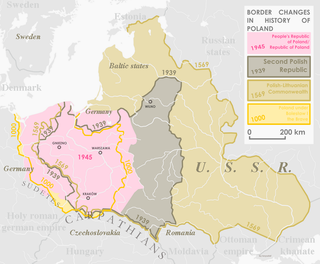Polonization

Poland's and the Commonwealth's historical borders
|
|
| Duration | 1569–1945 |
|---|---|
| Location | Poland throughout history |
| Borders | Khaki – 1569 Silver – 1939 Pink – 1945 |
Polonization (or Polonisation; Polish: polonizacja) was the acquisition or imposition of elements of Polish culture, in particular the Polish language, as experienced in some historic periods by the non-Polish populations of territories controlled or substantially under the influence of Poland. As with other examples of cultural assimilation, it could either be voluntary or forced and is most visible in the case of territories where the Polish language or culture were dominant or where their adoption could result in increased prestige or social status, as was the case of the nobility of Ruthenia and Lithuania. To a certain extent Polonization was also administratively promoted by the authorities, particularly in the period following World War II.
Polonization can be seen as an example of cultural assimilation. Such a view is widely considered applicable to the times of the Polish-Lithuanian Commonwealth (1569–1795) when the Ruthenian and Lithuanian upper classes were drawn towards the more Westernized Polish culture and the political and financial benefits of such a transition, as well as, sometimes, by the administrative pressure exerted on their own cultural institutions, primarily the Orthodox Church. The conversion to the Roman Catholic (and to a lesser extent, Protestant) faith was often the single most important part of the process. For Ruthenians of that time, being Polish culturally and Roman Catholic by religion was almost the same. This aspect of Polonization that led to the diminishing of the Orthodox Church was the part that was most resented by the Belarusian and Ukrainian masses. In contrast the Lithuanians, who were mostly Catholic, were in danger of losing their cultural identity as a nation, but that did not become evident for the wide masses of Lithuanians until the Lithuanian national renaissance in the middle of the 19th century.
...
Wikipedia
